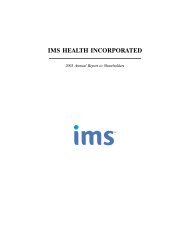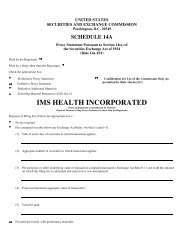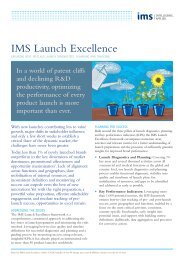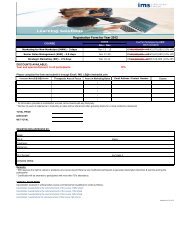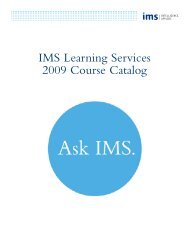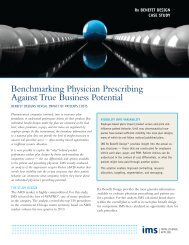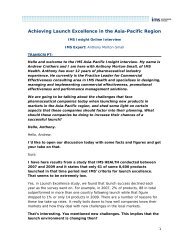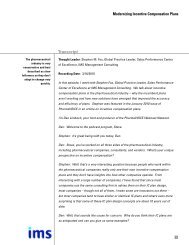Launch Excellence in the Diabetes Market: Lessons from - IMS Health
Launch Excellence in the Diabetes Market: Lessons from - IMS Health
Launch Excellence in the Diabetes Market: Lessons from - IMS Health
Create successful ePaper yourself
Turn your PDF publications into a flip-book with our unique Google optimized e-Paper software.
<strong>Launch</strong> <strong>Excellence</strong><br />
<strong>in</strong> <strong>the</strong> <strong>Diabetes</strong> <strong>Market</strong><br />
<strong>Lessons</strong> <strong>from</strong> History<br />
WHITE PAPER | DIABETES LAUNCH EXCELLENCE
WHITE PAPER | DIABETES LAUNCH EXCELLENCE<br />
Growth <strong>in</strong> <strong>the</strong> market for Type II <strong>Diabetes</strong> treatments has consistently<br />
out-performed <strong>the</strong> pharmaceutical market as a whole, and <strong>IMS</strong> believes that<br />
this will cont<strong>in</strong>ue for <strong>the</strong> next decade, driven by <strong>the</strong> obesity epidemic, an<br />
ag<strong>in</strong>g population, and <strong>the</strong> advent of new <strong>the</strong>rapies. In fact, <strong>in</strong> <strong>IMS</strong>’s<br />
perspective, diabetes stands out as one of <strong>the</strong> elite group of major <strong>the</strong>rapy<br />
areas that will cont<strong>in</strong>ue to outperform <strong>the</strong> market as a whole to 2016. With<strong>in</strong><br />
this out-perform<strong>in</strong>g group, it is also <strong>the</strong> only primary-care-driven <strong>the</strong>rapy<br />
area of any size, <strong>the</strong> o<strong>the</strong>rs be<strong>in</strong>g specialist areas.<br />
However, while epidemiology and unmet need mean <strong>the</strong>re are multi-billion<br />
dollar opportunities for successful launches and many potential contenders<br />
for blockbuster status, success is still not a foregone conclusion.<br />
<strong>IMS</strong> has studied <strong>the</strong> launch strategies and subsequent market performance of<br />
<strong>the</strong> frontrunner products <strong>in</strong> <strong>the</strong> dipeptidyl peptidase IV (DPP-IV) <strong>the</strong>rapeutic<br />
class worldwide to understand what separates clear market leaders <strong>from</strong> those<br />
with less impressive sales. From this, we’ve drawn key learn<strong>in</strong>gs pert<strong>in</strong>ent to<br />
companies prepar<strong>in</strong>g to launch one of <strong>the</strong> many products currently <strong>in</strong><br />
development for Type II <strong>Diabetes</strong>.<br />
THE NEXT DECADE: A CROWDED FIELD<br />
Over <strong>the</strong> next ten years, most of <strong>the</strong> new <strong>the</strong>rapies <strong>in</strong>troduced for Type II <strong>Diabetes</strong> will<br />
cluster <strong>in</strong> just a few drug classes, mean<strong>in</strong>g that <strong>the</strong> market will see a small number of<br />
first-<strong>in</strong>-class launches followed by an avalanche of follower brands. These follower<br />
products will naturally face a challeng<strong>in</strong>g launch environment if <strong>the</strong>y cannot<br />
demonstrate value propositions that are differentiated <strong>from</strong> first-<strong>in</strong>-class products <strong>in</strong><br />
<strong>the</strong> eyes of cl<strong>in</strong>ical op<strong>in</strong>ion leaders, prescribers, and payers.<br />
Never<strong>the</strong>less, experience has shown that companies whose products are not first to<br />
market can still w<strong>in</strong>—<strong>in</strong> specific segments or countries. Here, we exam<strong>in</strong>e how various<br />
strategies have played out for companies market<strong>in</strong>g DPP-IV <strong>in</strong>hibitors and consider<br />
<strong>the</strong> implications for products <strong>in</strong> <strong>the</strong> pipel<strong>in</strong>e.<br />
<strong>IMS</strong> HEALTH | LAUNCH EXCELLENCE IN THE DIABETES MARKET 2
WHITE PAPER | DIABETES LAUNCH EXCELLENCE<br />
DPP-IVs: CHANGING THE TREATMENT REGIMEN<br />
Of <strong>the</strong> two recent new product classes to treat Type II <strong>Diabetes</strong>, <strong>the</strong> oral DPP-IVs and<br />
<strong>the</strong> <strong>in</strong>jectable GLP-1s, DPP-IV <strong>in</strong>hibitors stand out for <strong>the</strong>ir success <strong>in</strong> overall sales<br />
levels, as <strong>the</strong>y are used earlier and for a broader group of patients than <strong>the</strong> GLP-1s.<br />
Although <strong>the</strong>re is a range of exist<strong>in</strong>g oral diabetes <strong>the</strong>rapies, <strong>the</strong> fact that no class<br />
provides a def<strong>in</strong>itive <strong>the</strong>rapeutic approach to <strong>the</strong> disease means <strong>the</strong>re is always<br />
opportunity for new classes of oral agents for patients post metform<strong>in</strong> mono<strong>the</strong>rapy.<br />
DPP-IVs came <strong>in</strong>to a largely generic oral market where <strong>the</strong> only on-patent oral agents,<br />
<strong>the</strong> Thiazolid<strong>in</strong>ediones (TZDs), were approach<strong>in</strong>g loss of exclusivity, with one of <strong>the</strong><br />
two members of <strong>the</strong> class, Avandia ® (rosiglitazone), fac<strong>in</strong>g a major question on safety.<br />
The first DPP-IV <strong>in</strong>hibitor on <strong>the</strong> market was Januvia ® (sitaglipt<strong>in</strong>), <strong>in</strong>troduced <strong>in</strong> <strong>the</strong><br />
U.S. <strong>in</strong> 2006 by Merck & Co. (Novartis’s Galvus ® (vildaglipt<strong>in</strong>) was delayed <strong>in</strong> <strong>the</strong> U.S.<br />
due to questions of side effects). S<strong>in</strong>ce <strong>the</strong>n, fur<strong>the</strong>r DPP-IVs, Onglyza ® (saxaglipt<strong>in</strong>)<br />
and Tradjenta (l<strong>in</strong>aglipt<strong>in</strong>) have also entered <strong>the</strong> market, and <strong>the</strong> pipel<strong>in</strong>e promises<br />
more to come.<br />
In <strong>the</strong> five years s<strong>in</strong>ce, DPP-IVs have captured 33 percent of worldwide sales of<br />
non-<strong>in</strong>sul<strong>in</strong>, anti-diabetic products. And <strong>in</strong> <strong>the</strong> mature eight markets, DPP-IVs<br />
account for 58 percent of <strong>the</strong> value growth <strong>in</strong> diabetes treatments.<br />
JANUVIA: FIRST TO MARKET TAKES ALL<br />
Januvia now dom<strong>in</strong>ates sales of DPP-IV products <strong>in</strong> developed markets. In 2011, <strong>the</strong><br />
brand accounted for approximately 80 percent of worldwide sales for pla<strong>in</strong> DPP-IV<br />
<strong>in</strong>hibitors. Later launches <strong>in</strong> <strong>the</strong> class—such as Onglyza and Galvus—have been unable<br />
to unseat Januvia <strong>from</strong> its leadership position.<br />
In <strong>the</strong> U.S., Januvia enjoyed three years of exclusivity <strong>in</strong> its class before<br />
AstraZeneca/BMS <strong>in</strong>troduced Onglyza. Dur<strong>in</strong>g this time, Januvia used strong<br />
promotion to ga<strong>in</strong> early buy-<strong>in</strong> <strong>from</strong> stakeholders and to build a positive brand image.<br />
It secured its place as “<strong>the</strong>” glipt<strong>in</strong>, an image that AstraZeneca/BMS was unable to<br />
change despite heavy U.S. promotional <strong>in</strong>vestment.<br />
Similar market dynamics occurred <strong>in</strong> Europe where Januvia was launched <strong>in</strong> 2007.<br />
Here, <strong>the</strong> next pla<strong>in</strong> DPP-IV <strong>in</strong>hibitor to be launched was Galvus, <strong>in</strong> 2008. S<strong>in</strong>ce <strong>the</strong>n<br />
Galvus has achieved sales of just 12 percent of those seen for Januvia <strong>in</strong> Europe.<br />
Januvia’s success is particularly mean<strong>in</strong>gful because <strong>the</strong> brand has not demonstrated<br />
any cl<strong>in</strong>ically relevant differentiation over o<strong>the</strong>r products <strong>in</strong> <strong>the</strong> class 1 . This suggests<br />
that <strong>the</strong> variance <strong>in</strong> performance with<strong>in</strong> <strong>the</strong> class was aided by Januvia’s position as<br />
first <strong>in</strong> class. Januvia was <strong>in</strong> <strong>the</strong> right place at <strong>the</strong> right time, and when subsequent<br />
entries came along, physicians generally did not move <strong>from</strong> <strong>the</strong>ir first glipt<strong>in</strong> choice.<br />
FOOTNOTE:<br />
1 Key op<strong>in</strong>ion leaders were unaware of any differentiation between products <strong>in</strong> <strong>the</strong> class, and <strong>the</strong> only head-to-head trial <strong>in</strong> <strong>the</strong> class showed<br />
Januvia’s 100mg “non-<strong>in</strong>feriority” compared to Onglyza 5 mg. Source: <strong>IMS</strong> <strong>in</strong>terviews with Key Op<strong>in</strong>ion Leaders as part of <strong>IMS</strong>’s Therapy<br />
Prognosis research program.<br />
<strong>IMS</strong> HEALTH | LAUNCH EXCELLENCE IN THE DIABETES MARKET 3
WHITE PAPER | DIABETES LAUNCH EXCELLENCE<br />
FIXED-DOSE COMBINATIONS: A SECOND CHANCE TO BE FIRST<br />
Whilst it has been standard for pla<strong>in</strong> oral agents to be followed by <strong>the</strong>ir comb<strong>in</strong>ation<br />
with metform<strong>in</strong>, for TZDs <strong>the</strong>se products were very much second brands. With <strong>the</strong><br />
glipt<strong>in</strong>s, <strong>the</strong> launch of <strong>the</strong> comb<strong>in</strong>ation has been an opportunity to ga<strong>in</strong> competitive<br />
advantage.<br />
In <strong>the</strong> major European markets, Novartis launched its comb<strong>in</strong>ation product, Eucreas ®<br />
(vildaglipt<strong>in</strong>/metform<strong>in</strong>), concurrently with its pla<strong>in</strong> product, Galvus. So, while<br />
Galvus was <strong>the</strong> second-to-market pla<strong>in</strong> product, Eucreas was <strong>the</strong> first launched<br />
comb<strong>in</strong>ation DPP-IV product. (See Fig. 1).<br />
FIGURE 1: LAUNCH OF FIRST COMBINATION DPP-IVs IN THE EU<br />
2008 2009 2010<br />
Mar Apr May Jun Jul Aug Sep Oct Nov Dec Jan Feb Mar Apr May Jun Jul Aug Sep Oct Nov Dec Jan Feb Mar<br />
Eucreas launched 2 yrs ahead of Janumet <strong>in</strong> UK<br />
In contrast, Merck delayed launch<strong>in</strong>g its fixed-dose comb<strong>in</strong>ation product, Janumet®<br />
(sitaglipt<strong>in</strong>/metform<strong>in</strong>) until a year after Januvia, its s<strong>in</strong>gle-compound product, was<br />
on <strong>the</strong> market. This meant that Janumet was <strong>the</strong> second-to-market comb<strong>in</strong>ation<br />
product. In fact, it lagged beh<strong>in</strong>d Eucreas by a full two years <strong>in</strong> <strong>the</strong> U.K.<br />
Uptake of Eucreas did not match that of Janumet across <strong>the</strong> top five European<br />
countries—likely because Janumet benefited <strong>from</strong> Januvia’s established patient base.<br />
(See Fig. 2.) However, with<strong>in</strong> Novartis’s product family, Eucreas performed<br />
significantly better than Galvus <strong>in</strong> most European markets. This is most apparent <strong>in</strong><br />
Spa<strong>in</strong> where <strong>in</strong> 2011, Eucreas and Galvus accounted for 34 percent and 3 percent of<br />
<strong>the</strong> DPP-IV <strong>in</strong>hibitor market, respectively. Sales for Eucreas amounted to 83% of<br />
Janumet sales, far exceed<strong>in</strong>g Galvus’ performance. The lesson here is that it might<br />
well be worthwhile to give as much—if not greater—focus to <strong>the</strong> launch of <strong>the</strong><br />
comb<strong>in</strong>ation product as to <strong>the</strong> launch of <strong>the</strong> pla<strong>in</strong> product.<br />
<strong>IMS</strong> HEALTH | LAUNCH EXCELLENCE IN THE DIABETES MARKET 4
WHITE PAPER | DIABETES LAUNCH EXCELLENCE<br />
FIGURE 2: DPP-IV SALES/SHARE FOR SINGLE AND COMBINATION PRODUCTS IN EU<br />
Share <strong>Market</strong><br />
SHARE OF SALES BY COUNTRY* 2011 IN US$<br />
100%<br />
90%<br />
80%<br />
70%<br />
60%<br />
50%<br />
40%<br />
30%<br />
20%<br />
10%<br />
0%<br />
2%<br />
7%<br />
3%<br />
6%<br />
5%<br />
10%<br />
3%<br />
3%<br />
5%<br />
8%<br />
14%<br />
19%<br />
15% 34%<br />
6%<br />
4%<br />
31%<br />
45%<br />
41%<br />
32%<br />
37%<br />
34%<br />
41%<br />
19%<br />
France Germany Italy Spa<strong>in</strong> UK<br />
*Includes licensed brands across Europe<br />
79%<br />
Galvus<br />
Onglyza<br />
Eucreas<br />
Janumet<br />
Januvia<br />
CUMULATIVE SALES OVER TIME, EU5*<br />
The competitive success of Eucreas versus Galvus raises questions about <strong>the</strong> relative<br />
importance of <strong>the</strong> pla<strong>in</strong> and comb<strong>in</strong>ation products <strong>in</strong> overall diabetes brand success.<br />
Novartis’ comb<strong>in</strong>ation product (Eucreas) is a far bigger proportion of vildaglipt<strong>in</strong>based<br />
sales than Merck’s comb<strong>in</strong>ation product (Janumet) is of sitaglipt<strong>in</strong>-based<br />
products. After two years on <strong>the</strong> market <strong>in</strong> France, Germany, and Spa<strong>in</strong>, for example,<br />
Eucreas represents 85-90 percent of vildaglipt<strong>in</strong> family sales. In contrast, Janumet<br />
represents 40-60 percent of sitaglipt<strong>in</strong> family sales two years after <strong>the</strong> launch.<br />
Indeed, with a sub-optimal pla<strong>in</strong> product launch, Novartis concentrated its<br />
promotional spend<strong>in</strong>g on Eucreas. In <strong>the</strong> first quarter post launch, <strong>the</strong> company’s<br />
promotional spend<strong>in</strong>g (as reported <strong>in</strong> <strong>IMS</strong> audits) on Eucreas was three times higher<br />
than it was for Galvus.<br />
In <strong>the</strong> U.S., <strong>the</strong> situation was different <strong>in</strong> that Merck’s products were <strong>the</strong> first to<br />
market both for <strong>the</strong> s<strong>in</strong>gle-compound <strong>the</strong>rapy (Januvia) and <strong>the</strong> comb<strong>in</strong>ation <strong>the</strong>rapy<br />
(Janumet). The second comb<strong>in</strong>ation product to come on <strong>the</strong> scene was Kombiglyze<br />
XR. (Kombiglyze XR conta<strong>in</strong>s saxaglipt<strong>in</strong> and metform<strong>in</strong> and was launched by BMS<br />
with AstraZeneca.) Kombiglyze XR has not been able to combat Janumet’s first-mover<br />
advantage and has seen poor uptake. In Q4 2011, Kombiglyze XR only accounted for<br />
two percent of <strong>the</strong> DPP-IV market, compared with 23 percent for Janumet.<br />
So, for both Novartis <strong>in</strong> Europe and Merck <strong>in</strong> <strong>the</strong> U.S., <strong>the</strong>re was a clear advantage to<br />
be<strong>in</strong>g first on <strong>the</strong> market with <strong>the</strong> comb<strong>in</strong>ation product—whe<strong>the</strong>r or not <strong>the</strong> same<br />
company was first to market with <strong>the</strong> pla<strong>in</strong> product.<br />
Companies whose products are not first to market can maximize <strong>the</strong>ir<br />
potential sales by pursu<strong>in</strong>g specific strategies.<br />
<strong>IMS</strong> HEALTH | LAUNCH EXCELLENCE IN THE DIABETES MARKET 5<br />
Cumulative Sales, LCUS$ m<br />
1,100<br />
1,000<br />
900<br />
800<br />
700<br />
600<br />
500<br />
400<br />
300<br />
200<br />
100<br />
0<br />
Q3 2007<br />
Q6 2007<br />
Q9 2007<br />
Q12 2007<br />
Q3 2008<br />
Q6 2008<br />
Q9 2008<br />
Q12 2008<br />
Q3 2009<br />
Q6 2009<br />
Q9 2009<br />
Q12 2009<br />
Q3 2010<br />
Q6 2010<br />
Q9 2010<br />
Q12 2010<br />
Q3 2011<br />
Q6 2011<br />
Q9 2011<br />
Q12 2011<br />
*European sales <strong>in</strong>clude local brand<strong>in</strong>g of Xelevia, Tesavel, Ristaben, Velmetia, Efficib, Ristfor, Zomarist, Icandra, Jalra and Xiliarx assigned<br />
accord<strong>in</strong>gly to Januvia, Janumet, Eucreas and Galvus.
WHITE PAPER | DIABETES LAUNCH EXCELLENCE<br />
PHARMERGING MARKETS: A DIFFERENT GAME<br />
The dynamics for first-to-market products are less rigid <strong>in</strong> <strong>the</strong> Tier 1 and Tier 2<br />
pharmerg<strong>in</strong>g markets than we’ve observed <strong>in</strong> developed markets. In Brazil, Russia,<br />
and India, for example, Merck’s Januvia was launched before Novartis’s Galvus.<br />
Never<strong>the</strong>less—and unlike mature markets—Novartis’s family of products accounted<br />
for more than 50 percent of <strong>the</strong> DPP-IV market <strong>in</strong> 2011. (See Fig. 3) Most of this<br />
success is attributable to Eucreas, which has outperformed Janumet considerably.<br />
Meanwhile, Galvus has held its own aga<strong>in</strong>st Januvia; its uptake has been comparable<br />
to that of Januvia <strong>in</strong> Brazil and Russia, and greater than Januvia <strong>in</strong> India.<br />
FIGURE 3: SPLIT OF DPP-IV CLASS VALUE SALES BY COUNTRY 2011 IN US$*<br />
Share of <strong>Market</strong><br />
100%<br />
90%<br />
80%<br />
70%<br />
60%<br />
50%<br />
40%<br />
30%<br />
20%<br />
10%<br />
0%<br />
6%<br />
35%<br />
36%<br />
3%<br />
20%<br />
EU5<br />
1%<br />
2%<br />
10%<br />
23%<br />
63%<br />
1%<br />
9%<br />
4%<br />
1%<br />
10%<br />
• In Brazil Galvus and Eucreas<br />
launched at <strong>the</strong> same time;<br />
21%<br />
24%<br />
17%<br />
Janumet lagged Januvia<br />
• Galvus embarked on a<br />
16%<br />
16%<br />
17%<br />
broader effort to promote<br />
than Januvia<br />
15%<br />
38%<br />
55%<br />
USA Brazil Russia India<br />
Tradjenta<br />
Kombiglyze XR<br />
Onglyza<br />
Janumet<br />
Januvia<br />
Galvus<br />
Eucreas<br />
*Galvus launched Jan 2012 <strong>in</strong> Ch<strong>in</strong>a so no sales data as yet. Galvus and Eucreas not launched <strong>in</strong> USA. Indian sales <strong>in</strong>clude local brand<strong>in</strong>g of<br />
Jalra, Jalra-M, Zomelis, Zomelis-M, Istamet and Istavel assigned accord<strong>in</strong>gly to Galvus, Eucreas, Januvia and Janumet.<br />
A number of <strong>in</strong>teract<strong>in</strong>g factors cause <strong>the</strong> differences <strong>in</strong> market dynamics between<br />
mature and pharmerg<strong>in</strong>g markets. The first is that companies may focus on mature<br />
markets at <strong>the</strong> expense of pharmerg<strong>in</strong>g markets based on assumptions about where<br />
<strong>the</strong> best return on <strong>in</strong>vestment may be achieved. It is time to revisit <strong>the</strong>se assumptions,<br />
consider<strong>in</strong>g that <strong>in</strong> 2011, comb<strong>in</strong>ed sales for non-<strong>in</strong>sul<strong>in</strong> anti-diabetics across BRIC<br />
were higher than <strong>the</strong>y were <strong>in</strong> each of Germany, France, or <strong>the</strong> UK. What is more,<br />
<strong>the</strong>se pharmerg<strong>in</strong>g markets experienced an average annual growth of 26 percent for<br />
diabetes products <strong>from</strong> 2007-2011—a rate that is expected to cont<strong>in</strong>ue. Although<br />
generic products currently dom<strong>in</strong>ate <strong>the</strong> pharmerg<strong>in</strong>g markets, growth of branded<br />
product sales is stellar, at 38 percent between 2010 and 2011.<br />
Local issues and local knowledge are also likely to have a big impact on <strong>the</strong> relative<br />
success of different DPP-IVs <strong>in</strong> <strong>the</strong> pharmerg<strong>in</strong>g markets. Novartis’s vildaglipt<strong>in</strong><br />
family of products ga<strong>in</strong>ed <strong>the</strong> upper hand <strong>in</strong> Brazil for a number of reasons. Novartis<br />
promoted Galvus more heavily than Merck promoted Januvia, and Novartis launched<br />
its two vildaglipt<strong>in</strong>-based products toge<strong>the</strong>r (whereas Merck launched Janumet after<br />
Januvia). These factors comb<strong>in</strong>ed to help Novartis achieve sales for its family of DPP-<br />
IVs that were 40 percent higher <strong>in</strong> 2011 than Merck’s were for <strong>the</strong> Januvia family.<br />
<strong>IMS</strong> HEALTH | LAUNCH EXCELLENCE IN THE DIABETES MARKET 6<br />
27%<br />
29%<br />
100%<br />
Ch<strong>in</strong>a
WHITE PAPER | DIABETES LAUNCH EXCELLENCE<br />
Ano<strong>the</strong>r opportunity is to employ different approaches to commercialization: w<strong>in</strong>n<strong>in</strong>g<br />
<strong>in</strong> pharmerg<strong>in</strong>g markets is driven by adaptation to <strong>the</strong> local environment, not by <strong>the</strong><br />
precedent of mature market success. In pharmerg<strong>in</strong>g markets, <strong>the</strong> importance of local<br />
knowledge means that “go<strong>in</strong>g it alone” may not be an effective strategy. This is<br />
illustrated <strong>in</strong> <strong>the</strong> different approaches and outcomes for Novartis and Merck <strong>in</strong> India.<br />
In late 2008, Novartis jo<strong>in</strong>ed forces with a local partner, USV, to co-promote Galvus<br />
and Eucreas. Local brand<strong>in</strong>g of <strong>the</strong> products as Jalra and Jalra-Met and a large sales<br />
force led to fast market penetration. In contrast, Merck did not capitalize on its firstto-market<br />
position, but waited until after Novartis launched Galvus to <strong>in</strong>crease its<br />
sales force. Eventually, three years after launch<strong>in</strong>g Januvia and more than two years<br />
after <strong>the</strong> Novartis/USV agreement, Merck partnered with Sun Pharma. Toge<strong>the</strong>r <strong>the</strong>y<br />
launched local brands, Istamet and Istamel, <strong>in</strong> 2011. This was too late to unseat<br />
Novartis’s products, however. In 2011, Novartis’s family of products had secured<br />
56 percent of <strong>the</strong> Indian DPP-IV market, compared with 34 percent for Merck’s family<br />
of products.<br />
DIFFERENTIATION: HOW MUCH IS ENOUGH?<br />
<strong>IMS</strong>’s research with Key Op<strong>in</strong>ion Leaders, providers, and payers suggest that recent<br />
DPP-IV launches have lacked clear and mean<strong>in</strong>gful po<strong>in</strong>ts of differentiation <strong>in</strong> <strong>the</strong><br />
eyes of prescribers and patients, despite manufacturers’ efforts to <strong>the</strong> contrary. <strong>IMS</strong><br />
Therapy Forecaster <strong>in</strong>terviews suggest that physicians tend to believe that “all DPP-<br />
IV <strong>in</strong>hibitors are <strong>the</strong> same”. That is, <strong>the</strong>y do not see <strong>the</strong> differentiation that exists as<br />
be<strong>in</strong>g cl<strong>in</strong>ically mean<strong>in</strong>gful. Onglyza, for example, is more potent than Januvia and<br />
Galvus, but <strong>the</strong> lower doses required with this product do not improve efficacy or<br />
safety. The dist<strong>in</strong>ction, <strong>the</strong>refore, doesn’t register with physicians.<br />
Patients, too, are difficult to sway. Kombiglyze XR is taken once daily, compared with<br />
twice daily for Janumet. From <strong>the</strong> uptake of Kombiglyze XR <strong>in</strong> <strong>the</strong> U.S., however, it<br />
would appear that patients do not value this additional convenience enough to switch<br />
medications.<br />
Given <strong>the</strong> size of <strong>the</strong> global diabetes market, segments of <strong>the</strong> diabetes population<br />
represent valuable opportunities, and new products can be targeted to capture <strong>the</strong>m.<br />
But, this strategy, too, is fraught with challenges. Boehr<strong>in</strong>ger Ingelheim targeted a<br />
niche patient segment—those with renal impairment—with Tradjenta because <strong>the</strong><br />
product is not excreted via <strong>the</strong> kidneys, unlike o<strong>the</strong>r DPP-IV <strong>in</strong>hibitors at <strong>the</strong> time.<br />
Although it rema<strong>in</strong>s to be seen if this product will be successful <strong>in</strong> <strong>the</strong> U.S., it is<br />
experienc<strong>in</strong>g slow uptake <strong>in</strong> Europe follow<strong>in</strong>g two blows. First, Onglyza received<br />
supplementary approval for <strong>the</strong> same patient group. Second, <strong>the</strong> German Institute for<br />
Quality and Efficiency <strong>in</strong> <strong>Health</strong> Care (IQWIG) failed to f<strong>in</strong>d that Tradjenta provided<br />
an added benefit and ruled that it should be compared not only aga<strong>in</strong>st o<strong>the</strong>r DPP-IV<br />
<strong>in</strong>hibitors, but aga<strong>in</strong>st o<strong>the</strong>r diabetic agents. This resulted <strong>in</strong> Boehr<strong>in</strong>ger Ingelheim<br />
choos<strong>in</strong>g not to launch <strong>in</strong> Germany ra<strong>the</strong>r than accept a sub-optimal price, with wider<br />
European ramifications.<br />
<strong>IMS</strong> HEALTH | LAUNCH EXCELLENCE IN THE DIABETES MARKET 7
WHITE PAPER | DIABETES LAUNCH EXCELLENCE<br />
Several comb<strong>in</strong>ation products that have recently launched have struggled because <strong>the</strong><br />
convenience of <strong>the</strong> comb<strong>in</strong>ation was simply not great enough for patients. Merck’s<br />
Juvasync (sitaglipt<strong>in</strong> and simvastat<strong>in</strong>) is a case <strong>in</strong> po<strong>in</strong>t. Patients still have to also<br />
take metform<strong>in</strong> along with it, and so it is no more convenient to take Juvasync plus<br />
metform<strong>in</strong> than to take Janumet and a separately adm<strong>in</strong>istered stat<strong>in</strong>. It could also be<br />
that patients and physicians prefer a regimen consist<strong>in</strong>g of Janumet and a separately<br />
adm<strong>in</strong>istered stat<strong>in</strong>, s<strong>in</strong>ce more recent stat<strong>in</strong>s (such as atorvastat<strong>in</strong>) may be preferred<br />
(and are now generic).<br />
Although differentiation of <strong>the</strong> follower products has not worked for <strong>the</strong> DPP-IVs, <strong>in</strong><br />
<strong>the</strong> <strong>in</strong>jectable GLP-1 segment of <strong>the</strong> diabetes market, <strong>the</strong> follower product, Novo<br />
Nordisk’s Victoza ® , has <strong>in</strong> fact done better than <strong>the</strong> first to market agent,<br />
Amyl<strong>in</strong>/Lilly's Byetta. Here, Victoza had some clear po<strong>in</strong>ts of differentiation to Byetta,<br />
<strong>in</strong>clud<strong>in</strong>g once daily adm<strong>in</strong>istration because of a longer half life, less risk of<br />
immunogenicity because it was fully humanized, and a superior performance <strong>in</strong><br />
lower<strong>in</strong>g blood-sugar levels <strong>in</strong> head-to-head trials. The lesson here is that<br />
differentiation of <strong>the</strong> follower can work if it is seen as cl<strong>in</strong>ically mean<strong>in</strong>gful by<br />
prescribers and payers and if benefits cannot be taken as a “class effect,” shared by all<br />
members of that class.<br />
Four more DPP-IV <strong>in</strong>hibitors are <strong>in</strong> late-stage development. The lessons of <strong>the</strong> first<br />
four products strongly suggest that, unless <strong>the</strong>re is true differentiation backed up with<br />
a very effective campaign across stakeholders, <strong>the</strong>y are likely to be chas<strong>in</strong>g ever<br />
decreas<strong>in</strong>g portions of <strong>the</strong> market <strong>in</strong> most countries, and at best will achieve limited<br />
success <strong>in</strong> certa<strong>in</strong> markets, such as <strong>the</strong> market<strong>in</strong>g company’s home market.<br />
Given <strong>the</strong> size of <strong>the</strong> global diabetes market, even patient niches represent<br />
valuable opportunities.<br />
FUTURE DIABETES CLASSES: FAMILIAR GROUND<br />
There are many companies with up-and-com<strong>in</strong>g treatments for Type II <strong>Diabetes</strong> <strong>in</strong> <strong>the</strong><br />
pipel<strong>in</strong>e; all should be look<strong>in</strong>g to apply <strong>the</strong> lessons of recent launches, as history tends<br />
to repeat itself given similar circumstances. And it does seem that <strong>the</strong> circumstances<br />
surround<strong>in</strong>g <strong>the</strong> next major class of drugs about to launch, <strong>the</strong> sodium-glucose<br />
transporter <strong>in</strong>hibitors (SGLT-2s), will give us déjà vu...<br />
Products <strong>in</strong> this class are likely to experience market dynamics that mirror those of <strong>the</strong><br />
DPP-IV <strong>in</strong>hibitors. Multiple examples of <strong>the</strong>se molecules are <strong>in</strong> late-stage<br />
development and are expected to launch around <strong>the</strong> same time. As with <strong>the</strong> DPP-IV<br />
<strong>in</strong>hibitors, <strong>IMS</strong> Key Op<strong>in</strong>ion Leader <strong>in</strong>terviews suggest <strong>the</strong> SGLT-2 <strong>in</strong>hibitors may not<br />
be clearly differentiated <strong>from</strong> one ano<strong>the</strong>r <strong>in</strong> <strong>the</strong> eyes of prescribers and payers <strong>in</strong><br />
terms of safety, efficacy, or convenience. The first-to-market product will <strong>the</strong>refore, as<br />
with Januvia, have a significant advantage, and European approval for AZ/BMS’s<br />
dapaglifloz<strong>in</strong> suggest that this agent will enjoy this role; however it may still be<br />
possible for late-to-market products to succeed if <strong>the</strong>y learn <strong>the</strong> lessons of <strong>the</strong> DPP-IVs.<br />
<strong>IMS</strong> HEALTH | LAUNCH EXCELLENCE IN THE DIABETES MARKET 8
WHITE PAPER | DIABETES LAUNCH EXCELLENCE<br />
The SGLT-2 <strong>in</strong>hibitors are dest<strong>in</strong>ed to be used <strong>in</strong> later l<strong>in</strong>es, so comb<strong>in</strong>ations with<br />
any of <strong>the</strong> exist<strong>in</strong>g diabetes classes could help <strong>in</strong> secur<strong>in</strong>g market share. In order for<br />
<strong>the</strong>se comb<strong>in</strong>ations to succeed, though, <strong>the</strong>y must provide a real convenience benefit<br />
to patients.<br />
Successful Strategies for <strong>the</strong> First to <strong>Market</strong><br />
• Do not allow be<strong>in</strong>g first to market tempt you <strong>in</strong>to complacency. Capitalize on your<br />
position, promot<strong>in</strong>g heavily to truly “own” <strong>the</strong> market prior to <strong>the</strong> launch of<br />
competitors.<br />
• <strong>Launch</strong> comb<strong>in</strong>ation products quickly <strong>in</strong> mature markets to reduce <strong>the</strong> open<strong>in</strong>g for<br />
competitors to establish a beachhead.<br />
• Don’t neglect pharmerg<strong>in</strong>g markets. To maximize your potential <strong>in</strong> <strong>the</strong>m, form<br />
alliances with local companies and consider local brand<strong>in</strong>g. Local partners have<br />
<strong>in</strong>-depth knowledge of <strong>the</strong> target market, can furnish local resources, and can<br />
extend sales force reach and make better use of local relationships and knowledge<br />
than <strong>the</strong>ir multi-national counterparts.<br />
• As competitors enter, emphasize homogeneity <strong>in</strong> <strong>the</strong> class as a whole, s<strong>in</strong>ce<br />
physicians tend not to switch patients off of exist<strong>in</strong>g <strong>the</strong>rapy for a new, but<br />
cl<strong>in</strong>ically comparable, product.<br />
Successful Strategies for Late-to-<strong>Market</strong> Products<br />
• Look beyond <strong>the</strong> largest markets for sales opportunities. The pharmerg<strong>in</strong>g markets<br />
may present opportunities to be first.<br />
• Treat comb<strong>in</strong>ation products as a second chance to be first. Aim to be first with a<br />
comb<strong>in</strong>ation product, and consider position<strong>in</strong>g, brand<strong>in</strong>g, and <strong>in</strong>vest<strong>in</strong>g <strong>in</strong> this<br />
product as if it were a completely new launch.<br />
• Identify po<strong>in</strong>ts of differentiation, but ensure <strong>the</strong>y are truly cl<strong>in</strong>ically relevant—and<br />
targeted toward identifiable patient segments and unmet needs.<br />
• Ensure that o<strong>the</strong>r differentiators—such as those that deliver patient convenience—<br />
will be recognized and appreciated by prescribers and patients.<br />
It might well be worthwhile to seize <strong>the</strong> first-to-market advantage with a<br />
comb<strong>in</strong>ation product, even if you don’t have a s<strong>in</strong>gle-compound product.<br />
<strong>IMS</strong> HEALTH | LAUNCH EXCELLENCE IN THE DIABETES MARKET 9
WHITE PAPER | DIABETES LAUNCH EXCELLENCE<br />
CONCLUSION<br />
The diabetes market is <strong>the</strong> s<strong>in</strong>gle large, predom<strong>in</strong>antly primary-care <strong>the</strong>rapy<br />
area that <strong>IMS</strong> forecasts will cont<strong>in</strong>ue to out-perform <strong>the</strong> pharmaceutical<br />
market as a whole. Accord<strong>in</strong>gly, <strong>the</strong> success of launches <strong>in</strong>to this market are<br />
of huge importance to many major pharmaceutical companies, and to <strong>the</strong><br />
health of <strong>the</strong> research-based pharmaceutical <strong>in</strong>dustry as a whole. Of <strong>the</strong> many<br />
products <strong>in</strong> development for Type II <strong>Diabetes</strong>, only a handful will enjoy firstmover<br />
advantage. That does not mean, however, that every o<strong>the</strong>r product<br />
need be an “also ran.” As we’ve seen with <strong>the</strong> DPP-IV <strong>in</strong>hibitors, it is possible,<br />
with <strong>the</strong> right strategy, tim<strong>in</strong>g, and resources, to enjoy strong market<br />
performance even as a later entrant.<br />
This po<strong>in</strong>t <strong>in</strong> time—with several major launches completed, but a number still<br />
on <strong>the</strong> way—is an ideal time to review and reflect upon past experience and<br />
ask what learn<strong>in</strong>gs can be applied to improve future diabetes launches. As <strong>the</strong><br />
Spanish-American philosopher George Santayana said: “Those who cannot<br />
remember <strong>the</strong> past are condemned to repeat it.”<br />
For fur<strong>the</strong>r <strong>in</strong>formation, please contact Sarah Rickwood or Carolyn Gauntlett<br />
SRickwood@uk.imshealth.com CGauntlett@uk.imshealth.com<br />
+44 (0)20 3075 5322<br />
www.imshealth.com<br />
We gratefully acknowledge <strong>the</strong> contributions of James Harris to <strong>the</strong> development of this white paper<br />
<strong>IMS</strong> HEALTH | LAUNCH EXCELLENCE IN THE DIABETES MARKET 10
WHITE PAPER | DIABETES LAUNCH EXCELLENCE<br />
<strong>IMS</strong> capabilities <strong>in</strong> <strong>Launch</strong> <strong>Excellence</strong><br />
<strong>IMS</strong> HEALTH | LAUNCH EXCELLENCE IN THE DIABETES MARKET<br />
Our proven framework – leveraged successfully<br />
with more than 50 launch teams – ensures<br />
best-<strong>in</strong>-class diagnostics, plann<strong>in</strong>g and track<strong>in</strong>g<br />
for optimal launch performance. We partner with<br />
clients for <strong>the</strong>ir end to end launch consult<strong>in</strong>g<br />
needs or can be flexible to work on selected issues<br />
and areas of focus.<br />
With an offer<strong>in</strong>g built on deep functional<br />
knowledge and expertise <strong>in</strong> more than 90 <strong>the</strong>rapy<br />
areas, we comb<strong>in</strong>e <strong>the</strong> skills and experience of<br />
1,700 <strong>IMS</strong> consultants across <strong>the</strong> launch spectrum,<br />
to drive best-practice launch execution and<br />
<strong>in</strong>ternal change management for our clients.
<strong>IMS</strong> HEALTH®<br />
EUROPE & WORLDWIDE<br />
210 Pentonville Road<br />
London N1 6JY<br />
United K<strong>in</strong>gdom<br />
Tel: +44 (0)20 3075 5888<br />
THE AMERICAS<br />
<strong>IMS</strong> <strong>Health</strong><br />
200 Campus Drive<br />
Collegeville, PA 19426<br />
USA<br />
Tel: +1 610 244-200<br />
For all office locations, visit: www.imshealth.com/locations<br />
ABOUT <strong>IMS</strong><br />
ASIA-PACIFIC<br />
10 Hoe Chiang Road<br />
Keppel Towers # 23-01/02<br />
S<strong>in</strong>gapore 089315<br />
Tel: 65-6227-3006<br />
JAPAN<br />
Toranomon Towers Office 4-1-28<br />
Toranomon, M<strong>in</strong>ato-ku<br />
Tokyo 105-0001<br />
Japan<br />
Tel: 81-3-5425-9000<br />
<strong>IMS</strong> <strong>Health</strong> is <strong>the</strong> lead<strong>in</strong>g provider of <strong>in</strong>formation services for <strong>the</strong> healthcare <strong>in</strong>dustry around <strong>the</strong> world. The company<br />
draws on its global technology <strong>in</strong>frastructure and unique comb<strong>in</strong>ation of <strong>in</strong>-depth, sophisticated analytics, on-shore and<br />
off-shore commercial services, and consult<strong>in</strong>g platforms to help clients better understand <strong>the</strong> performance and value of<br />
medic<strong>in</strong>es. With a presence <strong>in</strong> 100+ countries and more than 55 years of <strong>in</strong>dustry experience, <strong>IMS</strong> <strong>Health</strong> serves lead<strong>in</strong>g<br />
decision makers <strong>in</strong> healthcare, <strong>in</strong>clud<strong>in</strong>g pharmaceutical manufacturers and distributors, providers, payers, government<br />
agencies, policymakers, researchers and <strong>the</strong> f<strong>in</strong>ancial community. Additional <strong>in</strong>formation is available at www.imshealth.com<br />
© 2012 <strong>IMS</strong> <strong>Health</strong> Incorporated. All rights reserved. DIABLEWP0712




